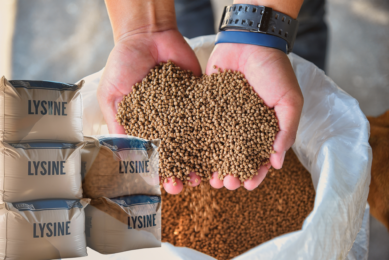How to improve digestibility of all nutrients?

Energy, protein and phosphorus account for the most important parts of the cost of feed. By using new generation enzymes, the digestibility of all nutrients can be improved.
The respective parts of energy, protein and phosphorus, average 64%, 27% and 9% of the diet cost. Although energy is not a nutrient per se, it originates from the metabolism of carbohydrates, lipids and proteins. Indeed, proteins retained at 50 to 60% at best greatly contribute to energy metabolism. Moreover, modern genotypes have largely been selected based on improving their feed intake and enhancing their protein deposition and thus appear more sensitive to dietary amino acid balance than to energy supply. For more than 20 years, enzymes have been used to improve feed digestibility and have allowed the use of more raw materials to help animal producers reduce their feed cost. Phytase has been used to get more phosphorus from plant phytates and reduce dietary mineral phosphate supplementation and thus phosphorus excretion.
Carbohydrases, designed to breakdown non-starch polysaccharides (NSP) which reduce feed digestibility, have long been considered as an important tool for feed formulators. Indeed, the large NSP such as arabinoxylans or β-glucans can be considered as anti-nutritional factors or factors that limit feed digestibility by either increasing digestive viscosity, encaging nutrients and thus limiting their availability or affecting the gut microbiota. NSP enzymes or carbohydrases have largely been used to get rid of those anti-nutritional factors, creating more value from the feed. Recent developments to carbohydrases in corn-based diets, or non-viscous diets, have shown that viscosity might not be the critical issue, but improving the accessibility to the nutrients is more crucial in order to get more out of the feed.
Mix of enzymes
The complex structure of the arabinoxylans requires a range of enzymes to be fully broken down. Indeed, due to their narrow specificity toward one linkage, different enzymes are required; endo-xylanases hydrolyze the xylose backbone, but their activity is frequently hampered by the substitution with arabinose residues. Arabinofuranosidases (ABF) are glycosyl hydrolases capable of cleaving arabinose from the backbone, thus allowing the endo-xylanases to function efficiently. Thus, several xylanases and ABF – or debranching enzymes – have to be used to get the full breakdown of complex arabinoxylans, such as that in corn or rice bran more branched than wheat or rye. Recent biotechnological developments have shown the possibility of enhancing the ABF profile of the enzyme solution, thereby improving the efficiency of the xylanases. NSP enzymes have mainly been accounted for in terms of energy availability. However, the improvement of their efficacy through a wider enzyme activity range is largely beyond the energy part of the feed. As shown in Table 1, the digestibility of most nutrients has been enhanced to a significant extent with this new generation of enzymes. In a standard diet (containing a wheat and soybean meal-based diet), a 3% improvement in overall organic matter digestibility is supported by higher starch, protein and fat digestibility. A more complex diet containing various raw materials richer in fibres exhibits higher protein and fat digestibility, supporting increased energy value.
Improvement of digestibility of all nutrients
When evaluating the effect of enzymes, energy availability has often been considered the main factor to take into account, and reformulating diets on energy, the current practice. Moreover, this reformulation has often been done through fat supplementation adjustment. As new generation enzymes improve the digestibility of all nutrients, is fat reformulation the best way to achieve an optimal enzyme response? It might not be. Taking into account the digestibility improvement, maintaining the amount of fat and increasing the amount of dietary fibre or polysaccharide in a diet would enhance the enzyme potential. As shown in Table 1, a complex diet rich in NSP and fat would exhibit a greater fat digestibility improvement with enzymes than a more conventional diet. Moreover, the antagonism between lowering the global fat content of the diet, which tends to impair feed conversion, and the enzyme addition, which would improve feed efficiency, should never be forgotten; thus, these opposite effects might result in the absence of the visible effect of the enzymes. Moreover, today the low dietary fat content of most commercial diets precludes identifying the enzyme benefit with such a strategy. Improvement of protein and amino acid digestibility also suggests the potential to reduce dietary nitrogen content and thus decrease the environmental impact, health-related issues due to indigestible proteins, substrate for non-beneficial bacteria and heat produced by protein catabolism. Therefore, energy and digestible amino acid reformulation will be a more precise approach for achieving better value from enzymes.
Figure 1 – Repartition of feed cost per nutrient for poultry.

Conclusion
When looking to minimise feed cost, profitability should always be considered. As the nutrient level increases, the feed cost also increases. However, due to improved bird performance, the revenue from birds also increases, and therefore the margin over the feeding cost is improved. The maximum margin is clearly not only produced by minimising the feed cost, but by also taking into account total nutrient digestibility instead of synthetic variables such as energy. Considering the effect of the enzyme on the amino acid’s digestible value and metabolisable energy has to be considered for the optimisation of both the feed cost and an improvement in performance. Indeed, growing broilers have shown a high response to amino acid supply, and balancing amino acid and energy appears to be a crucial constraint to fulfilling the bird requirement. Therefore, important scientific work still needs to be carried out for the integration of all parameters. The total digestibility concept or the effect of this new enzyme generation on all nutrient digestibility will have to be implemented in feed formulation software for practical and easy use.











